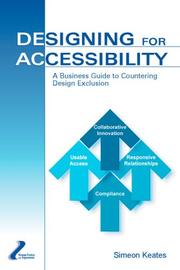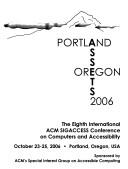| Listing 1 - 10 of 10 |
Sort by
|

ISBN: 0805860967 9780805860962 0805860975 9780805860979 Year: 2007 Publisher: Mahwah, N.J. Lawrence Erlbaum Associates
Abstract | Keywords | Export | Availability | Bookmark
 Loading...
Loading...Choose an application
- Reference Manager
- EndNote
- RefWorks (Direct export to RefWorks)
"Implementing design for accessibility within a company requires planning and forethought. Dr. Simeon Keates provides a step-by-step guide for companies on how to design inclusive products which can offer the right combination of functionality, usability and, equally importantly, accessibility. Accessibility is a new concept for many companies and this book is intended to serve as a means to demystify what is involved in designing for accessibility and help them offer products, services, and environments that do not discriminate between potential users on the grounds of capability."--Jacket.
Book
ISSN: 21915776 ISBN: 1447155793 1447155807 Year: 2013 Publisher: London : Springer,
Abstract | Keywords | Export | Availability | Bookmark
 Loading...
Loading...Choose an application
- Reference Manager
- EndNote
- RefWorks (Direct export to RefWorks)
The rise of the Internet and social media in particular offer great opportunities for brand owners to increase business and brand recognition. While this has clearly been of benefit to brand owners, who have seen a consequent rise in the value of their brands, it simultaneously makes those brands more attractive for exploitation or attack by others. Brand risks can come in many different types and this book provides examples of how these risks can arise as well as providing quantitative estimates of the adverse impacts that can result from such risks. Brand owners need to be aware of the risks and of the need to develop strategies for identifying and managing them. This book details the process by which a brand owner can develop a brand risk management process to protect a brand’s reputation and value. Rather than prescribe a one-size-fits-all approach, the authors provide guidance on how a brand risk management process can be tailored to particular needs and circumstances. This approach is underpinned by drawing on examples of best practice in the fields of risk management, interaction design and engineering design. This combined approach relies on developing an understanding of the risks faced by a particular brand owner, the full context of those risks and also the brand owner’s capabilities for identifying and managing those risks. This book contains many real-world examples and interviews with a number of brand owning organisations ranging from small companies to large multinationals.
Brand name products. --- Electronic commerce -- Risk management. --- Product counterfeiting -- Prevention. --- Product management -- Security measures. --- Engineering & Applied Sciences --- Computer Science --- Electronic commerce --- Product counterfeiting --- Product management --- Risk management. --- Prevention. --- Security measures. --- Brand management --- Management, Product --- Commercial product counterfeiting --- Counterfeiting of products --- Passing off (Product counterfeiting) --- Cybercommerce --- E-business --- E-commerce --- E-tailing --- eBusiness --- eCommerce --- Electronic business --- Internet commerce --- Internet retailing --- Online commerce --- Web retailing --- Brand names --- Branded merchandise --- Merchandise, Branded --- Name brand products --- Computer science. --- Computers. --- Law and legislation. --- E-commerce. --- Computer Science. --- Legal Aspects of Computing. --- e-Commerce/e-business. --- Marketing --- Counterfeits and counterfeiting --- Commerce --- Information superhighway --- Business names --- Commercial products --- Branding (Marketing) --- Trademarks --- Management --- Computers --- Cyberspace --- Law and legislation --- Automatic computers --- Automatic data processors --- Computer hardware --- Computing machines (Computers) --- Electronic brains --- Electronic calculating-machines --- Electronic computers --- Hardware, Computer --- Computer systems --- Cybernetics --- Machine theory --- Calculators
Book
ISBN: 3319671251 3319671243 Year: 2018 Publisher: Cham : Springer International Publishing : Imprint: Springer,
Abstract | Keywords | Export | Availability | Bookmark
 Loading...
Loading...Choose an application
- Reference Manager
- EndNote
- RefWorks (Direct export to RefWorks)
This textbook demonstrates the application of the finite element philosophy to the solution of real-world problems and is aimed at graduate level students, but is also suitable for advanced undergraduate students. An essential part of an engineer’s training is the development of the skills necessary to analyse and predict the behaviour of engineering systems under a wide range of potentially complex loading conditions. Only a small proportion of real-life problems can be solved analytically, and consequently, there arises the need to be able to use numerical methods capable of simulating real phenomena accurately. The finite element (FE) method is one such widely used numerical method. Finite Element Applications begins with demystifying the ‘black box’ of finite element solvers and progresses to addressing the different pillars that make up a robust finite element solution framework. These pillars include: domain creation, mesh generation and element formulations, boundary conditions, and material response considerations. Readers of this book will be equipped with the ability to develop models of real-world problems using industry-standard finite element packages.
Engineering. --- Computer simulation. --- Mathematical and Computational Engineering. --- Simulation and Modeling. --- Engineering mathematics. --- Computer modeling --- Computer models --- Modeling, Computer --- Models, Computer --- Simulation, Computer --- Electromechanical analogies --- Mathematical models --- Simulation methods --- Model-integrated computing --- Engineering --- Engineering analysis --- Mathematical analysis --- Mathematics --- Applied mathematics. --- Finite element method. --- FEA (Numerical analysis) --- FEM (Numerical analysis) --- Finite element analysis --- Numerical analysis --- Isogeometric analysis
Digital
ISBN: 9781447155805 Year: 2013 Publisher: London Springer
Abstract | Keywords | Export | Availability | Bookmark
 Loading...
Loading...Choose an application
- Reference Manager
- EndNote
- RefWorks (Direct export to RefWorks)
The rise of the Internet and social media in particular offer great opportunities for brand owners to increase business and brand recognition. While this has clearly been of benefit to brand owners, who have seen a consequent rise in the value of their brands, it simultaneously makes those brands more attractive for exploitation or attack by others. Brand risks can come in many different types and this book provides examples of how these risks can arise as well as providing quantitative estimates of the adverse impacts that can result from such risks. Brand owners need to be aware of the risks and of the need to develop strategies for identifying and managing them. This book details the process by which a brand owner can develop a brand risk management process to protect a brand’s reputation and value. Rather than prescribe a one-size-fits-all approach, the authors provide guidance on how a brand risk management process can be tailored to particular needs and circumstances. This approach is underpinned by drawing on examples of best practice in the fields of risk management, interaction design and engineering design. This combined approach relies on developing an understanding of the risks faced by a particular brand owner, the full context of those risks and also the brand owner’s capabilities for identifying and managing those risks. This book contains many real-world examples and interviews with a number of brand owning organisations ranging from small companies to large multinationals.
Applied marketing --- Computer science --- Computer. Automation --- e-business --- computers --- informatica --- e-commerce --- computercriminaliteit --- computerkunde
Digital
ISBN: 9783319671253 Year: 2018 Publisher: Cham Springer International Publishing
Abstract | Keywords | Export | Availability | Bookmark
 Loading...
Loading...Choose an application
- Reference Manager
- EndNote
- RefWorks (Direct export to RefWorks)
This textbook demonstrates the application of the finite element philosophy to the solution of real-world problems and is aimed at graduate level students, but is also suitable for advanced undergraduate students. An essential part of an engineer’s training is the development of the skills necessary to analyse and predict the behaviour of engineering systems under a wide range of potentially complex loading conditions. Only a small proportion of real-life problems can be solved analytically, and consequently, there arises the need to be able to use numerical methods capable of simulating real phenomena accurately. The finite element (FE) method is one such widely used numerical method. Finite Element Applications begins with demystifying the ‘black box’ of finite element solvers and progresses to addressing the different pillars that make up a robust finite element solution framework. These pillars include: domain creation, mesh generation and element formulations, boundary conditions, and material response considerations. Readers of this book will be equipped with the ability to develop models of real-world problems using industry-standard finite element packages.
Mathematics --- Applied physical engineering --- Engineering sciences. Technology --- Artificial intelligence. Robotics. Simulation. Graphics --- Computer. Automation --- ICT (informatie- en communicatietechnieken) --- vormgeving --- economie --- mineralen (chemie) --- simulaties --- mijnbouw --- wiskunde --- KI (kunstmatige intelligentie) --- ingenieurswetenschappen --- AI (artificiële intelligentie)
Book
ISBN: 1852337699 Year: 2004 Publisher: London Springer
Abstract | Keywords | Export | Availability | Bookmark
 Loading...
Loading...Choose an application
- Reference Manager
- EndNote
- RefWorks (Direct export to RefWorks)

ISBN: 1852337001 9781852337001 9781447100010 1447100018 Year: 2003 Publisher: London Springer
Abstract | Keywords | Export | Availability | Bookmark
 Loading...
Loading...Choose an application
- Reference Manager
- EndNote
- RefWorks (Direct export to RefWorks)
Inclusive Design: What's in It for Me? presents a comprehensive review of current practice in inclusive design. With emphasis on new ideas for improvement and arguments for wider implementation in future, a unique combination of leading opinions on inclusive design from both industry and academia are offered. The theme throughout encourages a positive view of inclusive design as a good and profitable process and to produce a change to more effective approaches to "design for all". Inclusive Design is composed of two parts with a common chapter structure so that the business and design arguments in favour of inclusive design can be easily compared and assimilated: The Business Case presents the industrial and management benefits of inclusive design. It concentrates on demographic, legal and ethical reasons for all businesses being better off taking inclusivity into account in the design of their products or services. Case histories demonstrating the commercial success of inclusive design are drawn from the experiences of companies such as Tesco, Fiat and The Royal Mail. The Designers' Case focuses on the factors a designer needs to take into account when dealing with inclusivity. "Who is going to use my design?" "What do they need from my design?" "How do I take any medical needs into account?" "Just how "inclusive" is my design?" are all questions answered in this section which presents the necessary tools for effective inclusive design. This part of the book aims to convince a designer that inclusive design is a realistic goal. Inclusive Design will appeal to designers, researchers and students and to managers making decisions about the research and design strategies of their companies.
Production management --- ergonomie --- Personnel management --- vormgeving --- Product strategy --- ergonomics --- design [discipline] --- Engineering design. --- People with disabilities. --- Barrier-free design. --- Universal design. --- Architecture --- Philosophy. --- Manufactures. --- Electronics. --- Microelectronics. --- Mechanical engineering. --- Economic policy. --- Engineering Design. --- Manufacturing, Machines, Tools, Processes. --- Electronics and Microelectronics, Instrumentation. --- Mechanical Engineering. --- R & D/Technology Policy. --- Economic nationalism --- Economic planning --- National planning --- State planning --- Economics --- Planning --- National security --- Social policy --- Engineering, Mechanical --- Engineering --- Machinery --- Steam engineering --- Microminiature electronic equipment --- Microminiaturization (Electronics) --- Electronics --- Microtechnology --- Semiconductors --- Miniature electronic equipment --- Electrical engineering --- Physical sciences --- Manufactured goods --- Manufactured products --- Products --- Products, Manufactured --- Commercial products --- Manufacturing industries --- Design, Engineering --- Industrial design --- Strains and stresses --- Design
Book
ISBN: 1614997926 9781614997924 9781614997917 Year: 2017 Publisher: Amsterdam, Netherlands
Abstract | Keywords | Export | Availability | Bookmark
 Loading...
Loading...Choose an application
- Reference Manager
- EndNote
- RefWorks (Direct export to RefWorks)

ISBN: 1595932909 Year: 2006 Publisher: ACM
Abstract | Keywords | Export | Availability | Bookmark
 Loading...
Loading...Choose an application
- Reference Manager
- EndNote
- RefWorks (Direct export to RefWorks)
Book
Year: 2006 Publisher: [Place of publication not identified] ACM
Abstract | Keywords | Export | Availability | Bookmark
 Loading...
Loading...Choose an application
- Reference Manager
- EndNote
- RefWorks (Direct export to RefWorks)
| Listing 1 - 10 of 10 |
Sort by
|

 Search
Search Feedback
Feedback About UniCat
About UniCat  Help
Help News
News